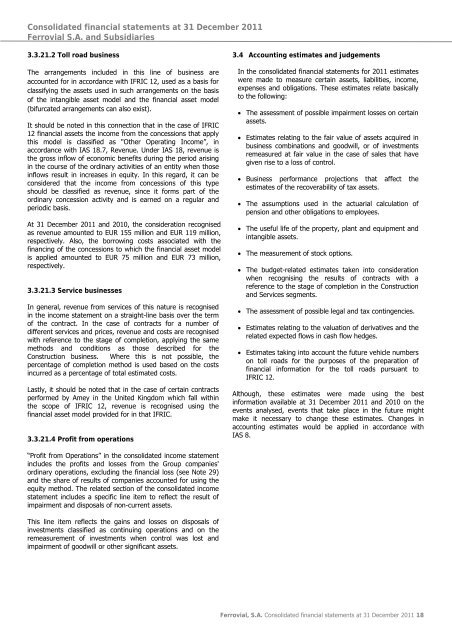Download - Ferrovial - Annual Report 2012
Download - Ferrovial - Annual Report 2012
Download - Ferrovial - Annual Report 2012
Create successful ePaper yourself
Turn your PDF publications into a flip-book with our unique Google optimized e-Paper software.
Consolidated financial statements at 31 December 2011<br />
<strong>Ferrovial</strong> S.A. and Subsidiaries<br />
3.3.21.2 Toll road business<br />
The arrangements included in this line of business are<br />
accounted for in accordance with IFRIC 12, used as a basis for<br />
classifying the assets used in such arrangements on the basis<br />
of the intangible asset model and the financial asset model<br />
(bifurcated arrangements can also exist).<br />
It should be noted in this connection that in the case of IFRIC<br />
12 financial assets the income from the concessions that apply<br />
this model is classified as "Other Operating Income”, in<br />
accordance with IAS 18.7, Revenue. Under IAS 18, revenue is<br />
the gross inflow of economic benefits during the period arising<br />
in the course of the ordinary activities of an entity when those<br />
inflows result in increases in equity. In this regard, it can be<br />
considered that the income from concessions of this type<br />
should be classified as revenue, since it forms part of the<br />
ordinary concession activity and is earned on a regular and<br />
periodic basis.<br />
At 31 December 2011 and 2010, the consideration recognised<br />
as revenue amounted to EUR 155 million and EUR 119 million,<br />
respectively. Also, the borrowing costs associated with the<br />
financing of the concessions to which the financial asset model<br />
is applied amounted to EUR 75 million and EUR 73 million,<br />
respectively.<br />
3.3.21.3 Service businesses<br />
In general, revenue from services of this nature is recognised<br />
in the income statement on a straight-line basis over the term<br />
of the contract. In the case of contracts for a number of<br />
different services and prices, revenue and costs are recognised<br />
with reference to the stage of completion, applying the same<br />
methods and conditions as those described for the<br />
Construction business. Where this is not possible, the<br />
percentage of completion method is used based on the costs<br />
incurred as a percentage of total estimated costs.<br />
Lastly, it should be noted that in the case of certain contracts<br />
performed by Amey in the United Kingdom which fall within<br />
the scope of IFRIC 12, revenue is recognised using the<br />
financial asset model provided for in that IFRIC.<br />
3.3.21.4 Profit from operations<br />
3.4 Accounting estimates and judgements<br />
In the consolidated financial statements for 2011 estimates<br />
were made to measure certain assets, liabilities, income,<br />
expenses and obligations. These estimates relate basically<br />
to the following:<br />
The assessment of possible impairment losses on certain<br />
assets.<br />
Estimates relating to the fair value of assets acquired in<br />
business combinations and goodwill, or of investments<br />
remeasured at fair value in the case of sales that have<br />
given rise to a loss of control.<br />
Business performance projections that affect the<br />
estimates of the recoverability of tax assets.<br />
The assumptions used in the actuarial calculation of<br />
pension and other obligations to employees.<br />
The useful life of the property, plant and equipment and<br />
intangible assets.<br />
The measurement of stock options.<br />
The budget-related estimates taken into consideration<br />
when recognising the results of contracts with a<br />
reference to the stage of completion in the Construction<br />
and Services segments.<br />
The assessment of possible legal and tax contingencies.<br />
Estimates relating to the valuation of derivatives and the<br />
related expected flows in cash flow hedges.<br />
Estimates taking into account the future vehicle numbers<br />
on toll roads for the purposes of the preparation of<br />
financial information for the toll roads pursuant to<br />
IFRIC 12.<br />
Although, these estimates were made using the best<br />
information available at 31 December 2011 and 2010 on the<br />
events analysed, events that take place in the future might<br />
make it necessary to change these estimates. Changes in<br />
accounting estimates would be applied in accordance with<br />
IAS 8.<br />
“Profit from Operations” in the consolidated income statement<br />
includes the profits and losses from the Group companies'<br />
ordinary operations, excluding the financial loss (see Note 29)<br />
and the share of results of companies accounted for using the<br />
equity method. The related section of the consolidated income<br />
statement includes a specific line item to reflect the result of<br />
impairment and disposals of non-current assets.<br />
This line item reflects the gains and losses on disposals of<br />
investments classified as continuing operations and on the<br />
remeasurement of investments when control was lost and<br />
impairment of goodwill or other significant assets.<br />
<strong>Ferrovial</strong>, S.A. Consolidated financial statements at 31 December 2011 18










